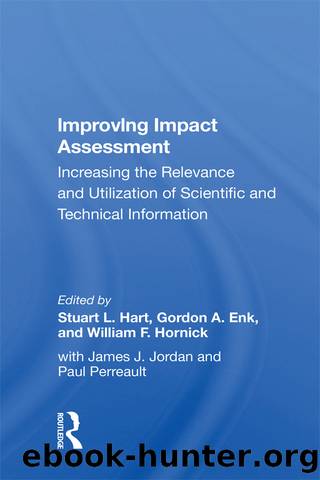Improving Impact Assessment: Increasing the Relevance and Utilization of Scientific and Technical Information by Stuart L Hart

Author:Stuart L Hart [Hart, Stuart L]
Language: eng
Format: epub
Tags: Political Science, General
ISBN: 9780429716621
Google: RCqNDwAAQBAJ
Goodreads: 44598388
Publisher: Routledge
Published: 2019-03-04T00:00:00+00:00
important in order to obtain a complete representation of value structures, increase available information, improve accountability, reduce conflict in decision making, and smooth implementation. An open, participatory process is also desirable to reduce possible abuses of power within the government, foster ideals of social belonging and self-determination, and educate the populace (McAllister, 1980).
Finally, many environmental assessments have been doomed to oblivion because of low decision-making utility. Data collection and analysis should be matched to the level and needs of the analysis; additional information has an expected value for benefits that can be compared to the costs. Additional information is only desirable if it affects decision making; lengthy discussions of irrelevant information can confuse decision makers. The goal of environmental assessment is to simplify reality rather than duplicate it (Holling, 1978). The temporal and spatial resolution of the analysis should be specific to the case.
Poor communication and presentation is a common cause of the failure to use environmental assessments. Communication can be improved by involving decision makers, environmental professionals, and publics as early as possible in the environmental assessment process. A method should be carried out in a way that is parsimonious and manageable, but not simplistic. Results should be summarized clearly in an easily understood format that tabulates facts and values. The results should be examined for validity, reliability, and freedom from systematic biases (Hyman, 1981a). Assumptions and key variables can be varied in sensitivity analyses so that decision makers can choose the set of assumptions they feel is most reasonable.
Environmental values are reflected in the policy process at different points and through several means. Legislative deliberations are the primary location for broad policy issues and, through the electoral system, are designed to reflect values, including environmental values, in a representative manner. But many specific policy choices that are of significance themselves or that constrain later broad policy choices cannot be made by legislatures. The administrative agencies making these specific policy choices are not designed to be representative; yet some form of democratic accountability is necessary for their proper performance. Various approaches to such accountability have been envisioned and implemented.
Recently, advances in accountability of administrative decision making in the context of multipleobjective analysis have been suggested by Haimes, Hall, and Freedman (1975) and by Keeney and Raiffa (1976). They are distinguished from other methods by at least two characteristics. First, they are careful to group the effects of alternative projects or programs into several accounts where the effects within each account are commensurable but effects in different accounts are incommensurable. Second, they provide formal mechanisms by which decision makers can assign relative values to each account to derive a ranking function that leads to a preferential ordering of alternatives. However, both of these methods have been largely restricted in their applications to participation by experts or by experts and a small group of key decision makers.
The method that is described here is believed to be superior to and easier to apply than either the Haimes, Hall, and Freedman approach or that of Keeney and Raiffa.
Download
This site does not store any files on its server. We only index and link to content provided by other sites. Please contact the content providers to delete copyright contents if any and email us, we'll remove relevant links or contents immediately.
Man-made Catastrophes and Risk Information Concealment by Dmitry Chernov & Didier Sornette(5674)
The Revenge of Geography: What the Map Tells Us About Coming Conflicts and the Battle Against Fate by Kaplan Robert D(3967)
Zero Waste Home by Bea Johnson(3662)
In a Sunburned Country by Bill Bryson(3379)
COSMOS by Carl Sagan(3364)
Good by S. Walden(3361)
The Fate of Rome: Climate, Disease, and the End of an Empire (The Princeton History of the Ancient World) by Kyle Harper(2884)
Camino Island by John Grisham(2723)
A Wilder Time by William E. Glassley(2701)
Organic Mushroom Farming and Mycoremediation by Tradd Cotter(2573)
The Ogre by Doug Scott(2510)
Human Dynamics Research in Smart and Connected Communities by Shih-Lung Shaw & Daniel Sui(2433)
Energy Myths and Realities by Vaclav Smil(2388)
The Traveler's Gift by Andy Andrews(2308)
9781803241661-PYTHON FOR ARCGIS PRO by Unknown(2275)
Inside the Middle East by Avi Melamed(2234)
Birds of New Guinea by Pratt Thane K.; Beehler Bruce M.; Anderton John C(2183)
A History of Warfare by John Keegan(2109)
Ultimate Navigation Manual by Lyle Brotherton(2058)
